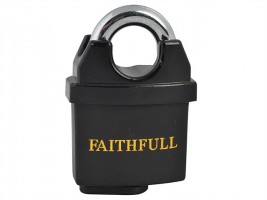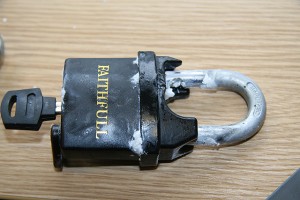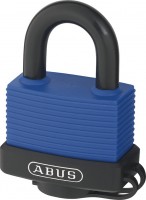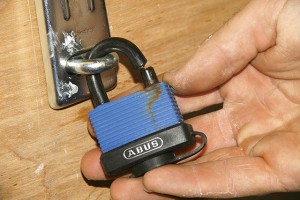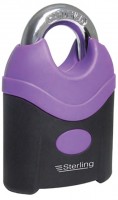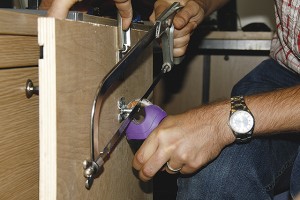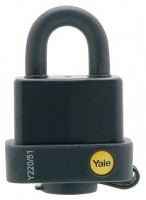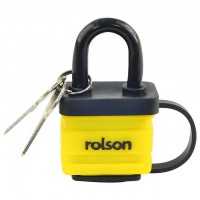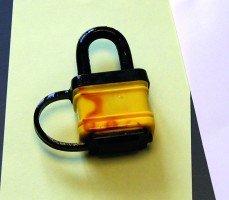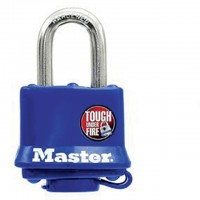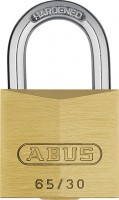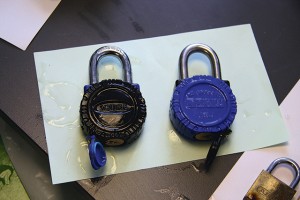Ben Meakins utilises a saltwater spray tank, bolt croppers and a hacksaw to assess the effectiveness (or otherwise) of a selection of padlocks when it comes to preventing boat break-ins
We all know that the marine environment is hard on things like padlocks – that’s why we tend to look for ‘weatherproof’ locks and equipment where possible. But, as we found out in this test, a label that says ‘waterproof’ or ‘weatherproof’ is no guarantee that a padlock will stand up to the salty, damp environment found on a small boat.
Our padlocks ranged in price from £2.50 to £16. At the cheapest end, our ‘weatherproof’ padlock was made from laminated steel, and its only sop to waterproofing was an ill-fitting plastic casing. This took a mere 6 seconds to break into. At the other end of the scale, we had a 70mm hardened steel ‘weatherproof’ lock. This had also rusted, although not as badly – but it took a good 10 minutes to break open with a hacksaw.
OK, you think, let’s go for stainless steel – it won’t corrode. But the problem with stainless is that it’s a much softer material than the hardened steel found in high-security padlocks. However, hardened steel is much less resistant to corrosion – it’s a tricky balance.
It surprised us just how easily even the most fearsome-looking padlock succumbed to a pair of bolt-croppers, which makes the decision even harder. As with most things in life, a compromise is needed.
One compromise is to go for a high-quality stainless-steel lock with a hasp design that makes it almost impossible to get the bolt croppers in – but how would a range of commonly available ‘weatherproof’ padlocks stand up to salt and a determined thief?
With the assistance of supplier www.padlocks.co.uk, we collected 12 together and set to work.
How we tested the best padlocks
We placed our selection of padlocks in a saltwater spray tank. This subjected them to a 10-second drenching every hour, spraying warm, salty water over the padlocks. These are difficult conditions for any metal to put up with, and would soon show which products were susceptible to corrosion.
We left them in the tank for a month, which would simulate more than a year of normal use. When we removed them, we tried a key in each one to see how well the innards had stood up to the abuse, before examining the exterior for corrosion and rust. This done, we could begin to try breaking in.
Using a set of 18in bolt croppers, we timed how long it would take to cut the shackle of each padlock. If the bolt croppers didn’t work or wouldn’t fit, we resorted to a hacksaw.
Faithfull Brass Weatherproof padlock
The packet for this hefty lock claims a ‘weatherproof PVC coating, hardened steel shackle and high security.’ It has a sliding cover for the keyhole.
After a month in our salt spray tank it was jammed with salty deposits.
After rinsing off, some corrosion around the key was evident as well as the shackle, and the key was hard to turn, requiring plenty of force.
It took a lot of effort and 22 seconds to break through with our bolt croppers – and the design of the body aimed to minimise the chance of getting the bolt croppers in.
Our hasp made it easy, but some others might be harder to access.
Price: £9.55
Attack resistance: 22 seconds
Note: We may earn a commission when you buy through links on our site, at no extra cost to you. This doesn’t affect our editorial independence.
ABUS Marine 701B/45
This ‘marine’ padlock comes encased in plastic with a snug-fitting seal for the keyhole.
It’s claimed to be ‘100% rust free’ and ‘saltwater-resistant’.
After its stay in our tank, there was some rusty deposit on the outside of the casing and a little green corrosion around the keyhole, but the lock opened easily and was otherwise unaffected.
It took us 8 seconds with the bolt croppers to break in.
Price: £12.60
Attack resistance: 8 seconds
Sterling 70mm closed shackle padlock
Described on the packet as ‘mid-security’, this padlock was the biggest on test.
It comprises a steel padlock with removable hardened steel shackle, and is described as weather-resistant.
However, after a month in the tank the shackle had gone very rusty, and the interior was full of salty corrosion.
Nonetheless, it put up a good fight, as could be expected for a hardened steel shackle 10mm in diameter.
The bolt croppers bounced off, and it took us nearly 10 minutes to break in with a hacksaw.
Price: £18.20
Attack resistance: 10 minutes
Yale 51mm Weatherproof padlock Y220/51
This weatherproof padlock is a laminated steel padlock encased in a heavy-duty plastic cover.
The cover did a good job of keeping damage at bay, although some salty water did make its way in: some corrosion was visible inside the case when we disassembled it for inspection.
The shackle, made from boron and encased in its cover, was unaffected, even where it met the main body of the padlock, thanks to a good rubber O-ring seal.
Breaking into it took 6 seconds.
Price: £14.99
Attack resistance: 6 seconds
Buy it now at building-supplies-online.co.uk
Rolson 40mm Laminated waterproof padlock
This cheap padlock featured an ill-fitting plastic cover and key cover and a chrome-plated shackle.
After a month in the tank, the shackle was unaffected, but the innards of the lock had rotted from the inside.
The key couldn’t be turned, even after rinsing and lubricating.
The coating on the laminated padlock had kept the salt at bay for a while, but it was showing signs of corrosion when we examined it.
It took us 6 seconds with the bolt croppers to break in.
Price: £2.50
Attack resistance: 6 seconds
ABUS Diskus 24iB/50
Described as ‘optimum protection’ due to its shape, which minimises the visible shackle to make it harder to attack with bolt croppers and hacksaws, this disc lock has a stainless steel body and shackle.
It was unaffected by corrosion in the tank and proved very difficult to break into. The problem was getting the croppers to bite as the space available was very limited.
A better hasp would further reduce the available space. We eventually managed it, but this wasn’t enough to release the lock, which remained stubbornly on the hasp.
The circular design means that the shackle won’t retract without the key, so a second cut is required. This proved a problem, as access was impossible from underneath.
A hacksaw eventually finished the job after much laborious sawing from the bottom up that would be tricky on some washboard designs.
Price: £16.11
Attack resistance: 8 minutes
Zone 900 Weatherproof padlock
This laminated padlock, encased in plastic with rubber seals, was similar at first glance to the Rolson padlock but is much better made, with a tight-fitting plastic cover that kept corrosion at bay.
Some rust was visible around the keyhole and inside the case, where water had penetrated via the shackle holes.
The key had become hard to turn and required lubrication and some working back and forth to return to normal.
The shackle, made from hardened steel, had begun to rust at a fault in the plastic covering but was unaffected for most of its length. It took 6 seconds to cut the shackle.
Price: £9.64
Attack resistance: 6 seconds
Masterlock WeatherTough padlock
Described as suitable for sheds, gates and boats, this lock has a hardened steel shackle and a laminated body with a plastic cover and dust cap that fits over the keyhole.
The insides were beginning to corrode after a month in the tank, with no rust.
The cover didn’t fit particularly well, and let some water in – and the key was also hard to turn.
It took us only 2 seconds to break in with the bolt croppers.
Price: £8.87
Attack resistance: 2 seconds
Small padlocks
We tried two small brass padlocks that were identical in appearance, but one had a stainless steel shackle and the other had hardened steel.
Abus Brass Padlock 65IB/30
This one had a brass body, and a stainless steel shackle. After its residence in our tank, there were no signs of corrosion and the lock operated normally.
It took only 1 second and an easy ‘snip’ with our bolt croppers to break in.
Price: £8.81
Attack resistance: 1 second
Abus Brass Padlock 65/30
Identical in appearance to the other small padlock. This one had a hardened steel shackle and a brass body.
After the tank, the shackle had begun to rust and there was some green corrosion visible around the keyhole and some resistance to the key.
It proved more resilient to the bolt croppers than the stainless version, but still took only 4 seconds to break into.
Price: £6.55
Attack resistance: 4 seconds
These two padlocks were similar versions of the same thing. They were both described as suitable for sheds, vans, boats, vans and gates, with the difference being that one had a stainless shackle and the other was hardened steel.
Squire All-terrain padlock ATL4
Described as ‘weather protected’, this ‘all-terrain padlock’ has a solid brass body with protective cover and a hardened steel shackle. A hinged cover secures the keyhole.
After a month in the tank a small amount of corrosion was visible around the keyhole, but the shackle was clear.
A small amount of salt corrosion was visible internally, but the mechanism worked well.
It took 31 seconds and a lot of effort to break in with the bolt croppers.
Price: 10.29
Attack resistance: 31 seconds
Squire Rustproof Lock ATL4S
Identical to the all-terrain padlock apart from the stainless shackle, this lock is described as rustproof.
This had no corrosion visible – the interior was clear and the keyhole had no rust at all. The internal workings were also unaffected.
It took marginally less time than the hardened shackle to break in, but still required a lot of effort with the bolt croppers.
Price: £12.35
Attack resistance: 27 seconds
PBO verdict
This test was eye-opening in that it showed just how easy it is to break into most padlocks. It highlights a major dilemma when choosing a padlock: you can’t just blindly buy a ‘weatherproof’ one and assume it’ll be OK on your boat.
There is an interesting compromise between stainless (higher corrosion resistance) and hardened steel (greater cutting resistance) – although the difference in break-in time, a matter of seconds, leads me to suspect that you’d be better off avoiding corrosion with a true weatherproof lock as it’ll offer much the same level of resistance to break-in while lasting much longer in the marine environment.
The best lock on test was the ABUS Diskus lock, which made access for the bolt croppers almost unachievable. The design of your washboards could make it impossible, for instance if it was under a ledge or the edge of a sliding hatch. We eventually managed to break in, but after a struggle.
Of the other locks, the Squire Rustproof lock was a good corrosion-proof design that lasted well, and the chunky Sterling closed shackle lock put up a valiant struggle but didn’t cope well with the corrosion.
Hasp design is important – choosing one which conceals as much of the shackle as possible will do more to secure your boat than padlock choice. Our advice is to choose the best, most corrosion-proof lock you can and combine it with a good hasp to act as the best deterrent possible.
Didn’t find what you’re looking for? Head to Amazon’s dedicated boating page for more marine products.






